09/13/2020
My wife and I were working on our home this weekend and came to a decision point most home owners have at one time or another. Should we mow the lawn or sell the house, buy an RV and move to a vegetarian commune in Patagonia? We compromised, deciding the lawn could wait until next weekend.
Instead, we tackled the portable twenty gallon parts cleaner that had been taking up space in the garage. Filled with primordial ooze, and rusting from the inside out, parts came out dirtier than when they went in and the recirculating pump had literally dissolved. The issue turned to salvage. Removing the tank and fabricating a work surface could result in a very nice rolling workbench. Alternatively, a similar approach could be used to make a portable potting table. You know, hoarder projects where nothing is really thrown out.
Mow the lawn? Disassemble the parts cleaner? Salvage? Metaphorically, the walls began to close in and the pressure became overwhelming. So we decided to look at RVs online and spend the weekend catching up on our reading.
Shotguns for defense and security
Firearms serve many roles, some critical, some recreational. Within each application, experience guides firearm selection, manufacturer’s guide firearm selection and firearm publications do their share of the same. Hopefully, when a decision is reached, the firearm will suit the person, or persons, it will serve. What is the consequence of a bad decision?
A poor choice for competitive shooting, and even for non-dangerous big game hunting, typically means no more than a lost match or an unrewarding hunting trip. However, with something as critical as a defensive firearm, where safety and perhaps survival are at stake, selection of a proper firearm is crucial.
Shotguns have played a role in my notion of home security; 12 gauge and 20 gauge, autoloader and pump, utilizing slug and shot loads. The purpose they continue to serve is protection when drawn out of the house to investigate a disturbance at night, where distance to the woodland tree line varies and house form, even under area lights, cast shadows and provide cover.
A shotgun is not used defensively inside my home for a number of reasons; layout of the house, movement and placement of occupants and locations of defensible positions. In my judgement, a shotgun would not provide sufficiently narrow coverage, it would endanger occupants and the shooting distances from defensible positions are too close to warrant a shotgun.
Outdoors at night, chances are that the need to defend would happen more quickly than in the day time and shooting distances would be greater than indoors, but still moderate. In this setting, a shotgun fits. Not a lecture directed at you, just some insight into one person’s perspective.
Remington V3 Tactical Solution

|
Remington V2 Tactical |
|
| Manufacturer | Remington Ilion, NY |
| Order # | 83442 |
| Type | Gas Operated Autoloader |
| Gauge | 12 (2 ¾” or 3″) |
| Capacity | 6+1 |
| Barrel Length | 18.5″ |
| Choke | Fixed Cylinder Bore |
| Weight | 7.6 Lbs |
| Overall Length | 39.5″ |
| Stocks | Synthetic |
| Hardware | Aluminum – Steel – Matte Black |
| Length of Pull | 14.2 |
| Drop at comb | 1 1/2″ |
| Drop at heel | 2 7/16″ |
| Sights | Vent Rib – Bead |
| Sight Mounting |
D&T For Rail |
| Trigger Pull | 4 Lbs. 3 Oz. |
| Safety | Cross Bolt |
| MSRP | $1,024 |
My current gun is a short barrel 12 gauge pump, fitted with a pressure switch actuated tactical light that is never used. The pump was my choice because, a few years ago, a preferred Versa Max Tactical proved too unwieldy for my purposes. The V3 Tactical addresses that issue without giving away anything central to my application.
The Remington V3 utilizes the same Versaport gas system design as the Versa Max, but the action is more compact; the Versa Max is a 3.5″ capacity action where the V3 is capped at 3″. Additionally, the V3 Tactical has a shorter barrel; 18.5″ compared to 22″. The result is the V3’s overall length reduction of four and one-half inches and a weight reduction of one-half pound.
Absent on the V3 Tactical are the Versa Max’s interchangeable choke tubes, adjustable stock, one round of magazine capacity and about 30% of the MSRP. Retained are the oversize charging handle, bolt release, and safety. This is not a suggestion that the Versa Max is overpriced. Rather, it is an assessment that the extra cost features useful to a bird hunter, or for clay target shooting, are not particularly useful within a defensive application.
I want to be careful when referencing feature similarities and differences between the V3 and Versa Max products, as these models share no common parts and vary substantially in design. As one example, the Versa Max recoil spring is embedded in the shotguns buttstock. The V3 recoil springs reside on dual guide rods and are contained within the receiver.
As noted previously, the V3 is a maximum 3″ shell design which contributes to the V3’s substantially more compact form. The V3 bolt assembly has a beefed up extractor and ejector. The V3 trigger assembly is simplified, more robust and incorporates elements of Remington target shotguns. The wide trigger feels light and crisp.
Another smart move on Remington’s part, the overall geometry and balance of the V3 was made to match that of the very popular Remington Model 1100. So the V3 would feel familiar to Model 1100 shooters and that trait makes it an easy shotgun to gain shooting proficiency.
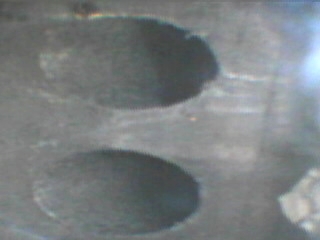 The Versaport gas system design is easy to maintain. The gas pistons drop in from the front of the gas block and the plugs go into the block to retain the pistons. Picture left, a substandard image from my borescope that illustrates port appearance.
The Versaport gas system design is easy to maintain. The gas pistons drop in from the front of the gas block and the plugs go into the block to retain the pistons. Picture left, a substandard image from my borescope that illustrates port appearance.
Within the V3’s barrel, eight ports pass through to the gas block, directing pressurized gas to the pistons when the shotgun is discharged. When a 2 3/4″ shell is chambered, all eight ports are exposed. When a longer 3″ shell is chambered, only four ports are exposed. A simple way to regulate gas volume and pressure to the gas block appropriate for the type of ammo selected.
In addition to the metering of gas from barrel to gas block, the Versaport system dumps excess gas. In the case of the V3, the excess escapes through vents at the rear of the forearm. No, no puffs of smoke or jet streams. The gas volume is small and it expands, slows and dissipates mostly within the forearm. The proof of the quality of the design is that the Remington Versaport guns are highly reliable and digest what they are fed.
“Joe, why are you droning on and on and… over the gas system?”. If you were paying attention at the onset, you’ll note that I said I have a pump shotgun as part of a home defense system. Why a pump? Because of the old adage that gas system guns are not rock solid reliable, which certainly does not apply to the Versaport system.
A sound defense?
What about the sound of a racking pump gun scaring off perpetrators. Are there some criminals who are not cut out for a life of crime and would faint at the presence of a gun? Not likely. Today’s criminals are hardened, violent and want to hurt their victims, as much as they want to take their victims’ possessions.The sound of a racking shotgun may do more to disclose a position by shouting “Look at me! Look at me! I’m over here!”.

At 6 shells, the V3 Tactical holds one less round in its extended magazine than the Versa Max Tactical; a function of magazine length tracking to an 18.5″ barrel rather than a 22″ barrel. For sling users, the V3 Tactical has a swivel mount location on the butt stock and an M-LOK slot on the clamp that holds the barrel and extended magazine together. The subject shotgun is supplied with a ventilated rib and bead sighting system. The #83441 version, $1,076 MSRP, is supplied with XS Low Profile open sights.
To Remington’s credit in putting together a tactical shotgun, the oversize controls are appreciated. Yes, they may seem like the push buttons on a geriatric telephone, but they are where they should be and as obvious as they should be on a defensive weapon.
The top of the receiver is drilled and tapped for sight mounts, which would most appropriately be a Picatinny rail. No, that isn’t British. I believe you are thinking of Piccadilly rails, which are the U.K. trains serving the greater Manchester Piccadilly area.
The “soft shooting 12 gauge” oxymoron… After owning and shooting a good number of heavy African big game caliber firearms, and a good number of pop shooter heavy weight target rimfire rifles, then shooting essentially everything else in between, I’ve become a pretty good judge of degrees of recoil across that spectrum. I do not believe “soft shooting” is an adjective that can precede the term “12 gauge”.
I would say that the gas powered action, stock geometry and excellent Remington SuperCell recoil pad make the V3 Tactical 12 gauge recoil very manageable. The V3 pad fit me much better than the adjustable length of pull pad setup found on the Versa Max.The pad also did not hang on my clothing and it offered excellent lateral stability.
Yes, I did shoot the Remington V3 Tactical
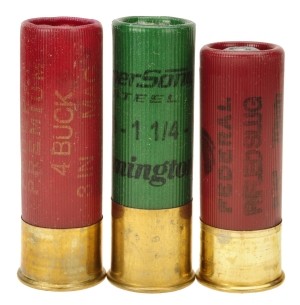 Three types of 12 gauge ammo were fired from the Remington V3 Tactical, from left to right: Federal Premium 3″ #4 Buck 41 pellets of copper plated shot @ 1210 fps (now rated at 1100 fps), Remington Hypersonic Steel 3″ #2 steel shot 156 pellets (1 1/4 oz) @ 1700 fps and Federal Power-Shok 2 3/4″ 1 oz rifled slug in deference to the V3 smooth bore. Why?
Three types of 12 gauge ammo were fired from the Remington V3 Tactical, from left to right: Federal Premium 3″ #4 Buck 41 pellets of copper plated shot @ 1210 fps (now rated at 1100 fps), Remington Hypersonic Steel 3″ #2 steel shot 156 pellets (1 1/4 oz) @ 1700 fps and Federal Power-Shok 2 3/4″ 1 oz rifled slug in deference to the V3 smooth bore. Why?
Empirical data
The ammunition presented has been used on wildlife of size and weight that would be similar to defense against a human threat and at the distances indicated. After years of shooting holes in blocks of synthetic ballistic gel to create photographic imagery, I fail to see the result correlation between gel and ballistic gel in the broad context often reported.
The Internet is loaded with lots of ballistic gel test results; sometimes just bare gel blocks, sometimes gel dressed in denim, sometimes the gel is fronted with some type of construction material. However, the execution of the test is almost always the same. One guy sits in a chair ten feet from the block, another guy stands to the side with his fingers in his ears, a shot is taken and then they both say in unison, “Hoo boy! Will you look at that?” and then the video is played back in slow motion to show the gel block wiggle and waggle on impact… shot from ten feet away.
I do not know where the ten foot shooting distance comes from, other than a minimum safe distance when shooting into a block of gel and sometimes as a component of the methodology used to qualify the density of gel medium. In any event, I have no picturesque gel block penetration results to offer and, as published results vary to extremes, I have no gel block reference data from others to offer.
The failings of long term relationships
There are shotgunners and shotguns that can cover serious distances. There are slug guns and slug ammunition that can rival typical sporting rifle accuracy at multiple hundreds of yards. For the deer, moose and hog hunter, that is exceptionally good news and an illustration of how far firearms and ammunition has come over even the past twenty five years. However, that is not my application or, I suspect, the intent of the Remington V3 Tactical.
Distances referenced below reflect distances anticipated in service. Important considerations due to shot disbursement varying with distance, the low ballistic coefficient of a full bore slug… the flying barn door syndrome and because of the rapid deceleration of low sectional density shot. My defensive shotgun intent is ten to fifteen yards for shot and twenty five to fifty yards for slugs.
Why not just replace the shotgun with a handgun on the short end and a rifle when going long? Changing circumstances where a shotgun can handle both. What begins very close up and appropriate for shot, can quickly evolve into something longer range. With only shotgun in hand, a transition can be made from shot with broad coverage to slug ammunition for more tightly controlled target acquisition.
.Bang, bang… bang
Fifteen yards on a 12″x18″ target, 33 of 41 #4 Buck pellets on target. Penetration at this distance would shred internal organs and the wound would be massive with 33 0.240″ pellet wound channels.
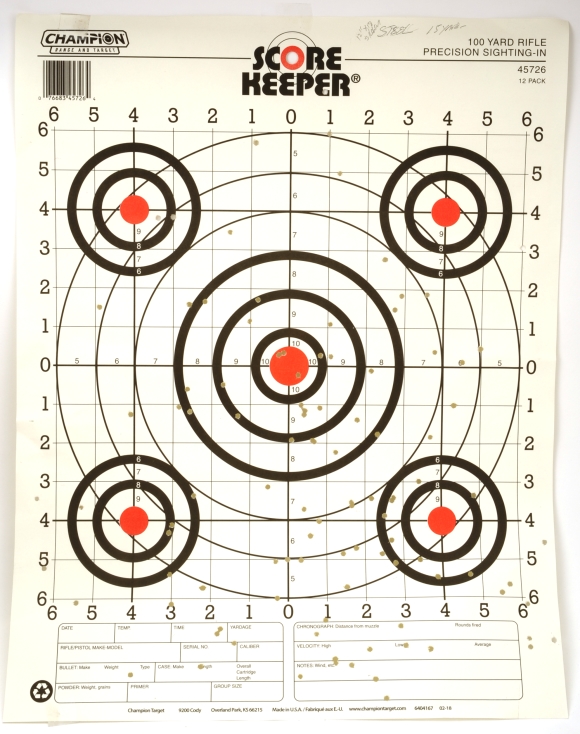
Fifteen yards on a 12″x18″ target, 91 of 156 #2 steel 0.150″ pellets on target. Less penetration, but certainly discouraging for a perpetrator and, again, the wound would be massive with 91 0.150″ pellet wound channels.
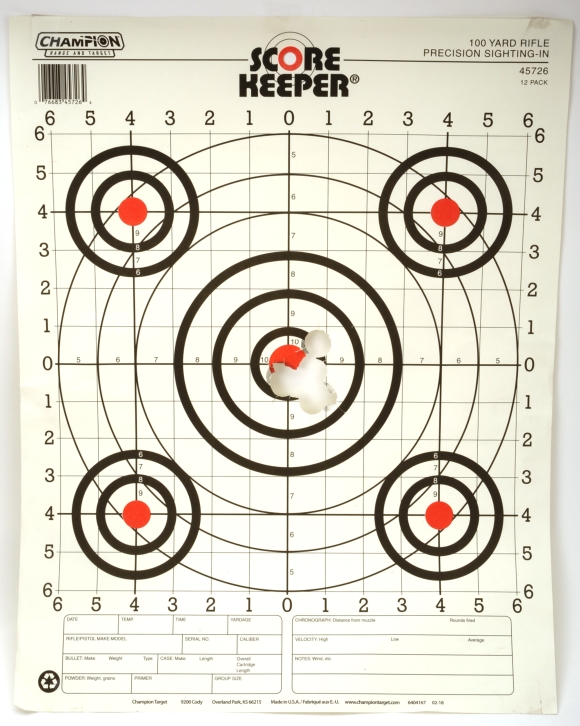
Above, a five shot, 25 yard group utilizing Federal rifles slugs. Could similar results be achieved at 50 yards? Sure, and the Federal slugs would penetrate enough to drop a deer at even at 50 yards and slug expansion would be huge… 1″+ in diameter. If deeper penetration and less expansion were desired, a 12 gauge copper projectile, sabot mounted 0.500″ projectile or solid cast slug rifled slug would work.
Overall, patterns and groups were quite good, especially for cylinder bore. The Remington V3 Tactical functionally did as well with target loads and quick shots yielded shattered clay targets. No, not my first choice for skeet, but that is not the Tactical configuration’s purpose.
Different tests, different testers, different results…
I did want to offer one last test for the Remington V3 Tactical that has been the gold standard for shotgun/shotshell testing for as long as I can remember. It is at least as valid as any other test I have seen conducted on the Internet. The elastomer material thickness standard is 10 mils deflated, charged volume must be 268 cubic inches, and charge pressure is 14.7 PSI. Clusters are arranged in groups of 7 units. The example below was shot at 15 yards with #2 steel shot.
Yes, that is a gratuitous “Hoo Boy! Look at that!” video and exploitation of balloons moment. Sometimes I have to have fun too.
Back to business… a summary
The Remington V3 Tactical is a fast handling shotgun that provides plenty of power and reliable operation.The V3’s light weight, neutral balance and short barrel make it an intuitive shooter.
I have tried a good number of point and sight systems between shot and slug guns; lights, lasers, enclosed red dot, compact open red dot, express sights, scopes, ribs, and bead combinations. Ultimately, my guns always end up with simple rib/bead setups because they are effective and there is little to break or fail. The V3 leaves the factory with the necessary system in place.
The V3 Tactical is a quick clean up. Field stripping is easy and requires no tools. Metal finishes and polymer stock wipe clean of powder residue and defend well against scratches, wear and corrosion. The surfaces are also non-reflective so you won’t find yourself trying to be stealthy while holding a signal mirror.
Time to retire my pump gun.


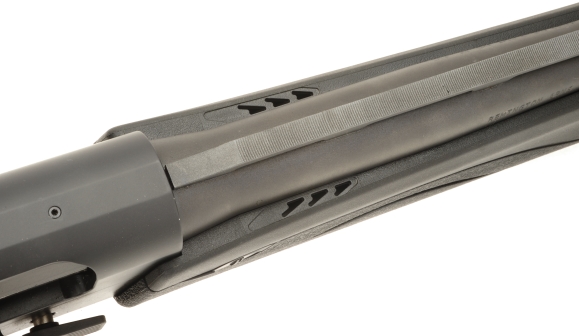
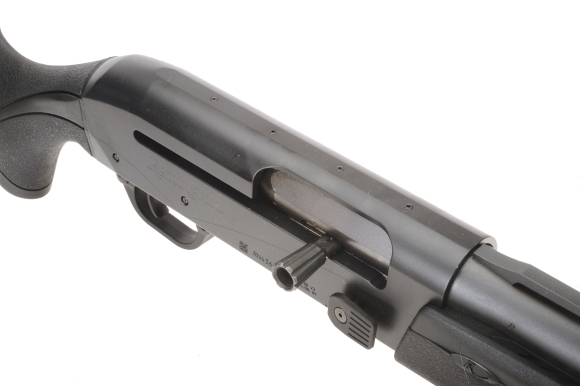
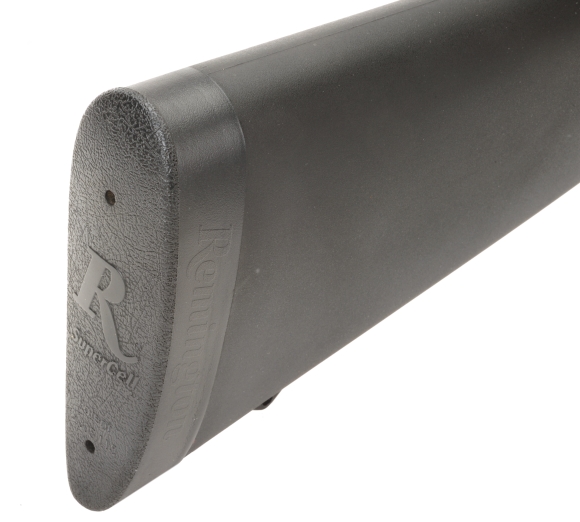
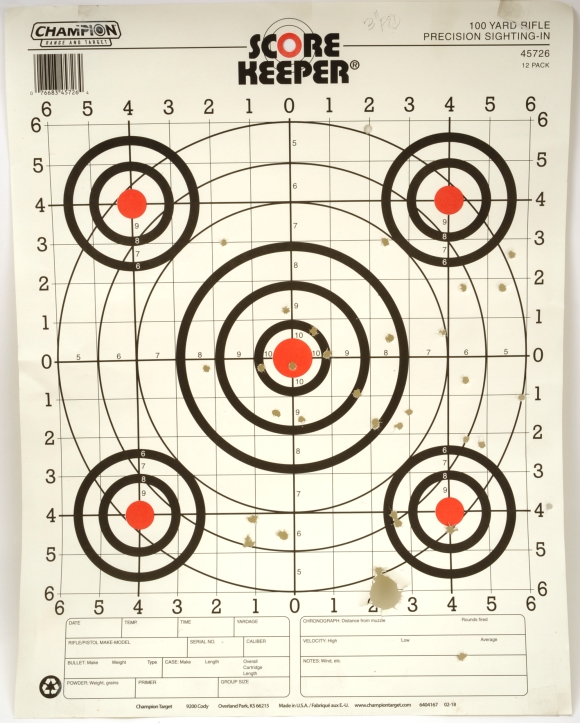


Email Notification